#helmeted guineafowl
Text




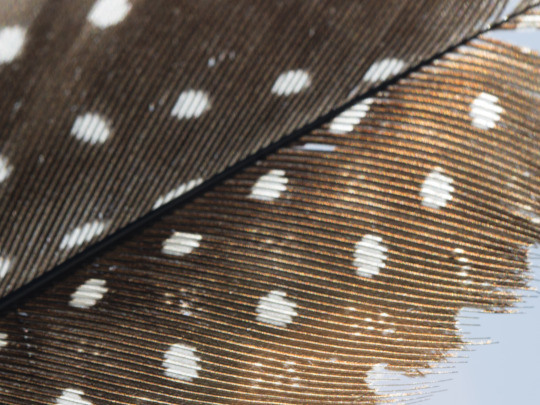
#bird#helmeted guineafowl#polka dots#feather#photographers on tumblr#textless#amadee ricketts#macro#kenya#masai mara#i love polka dots#so i was pretty excited about these polka dot birds
483 notes
·
View notes
Text

Helmeted guineafowl (Numida meleagris)
Part of a collection of watercolors by "M. Rabié" for St. Domingue Oiseaux. Dated 1766.
Internet Archive
100 notes
·
View notes
Text

Helmeted Guineafowl
67 notes
·
View notes
Text
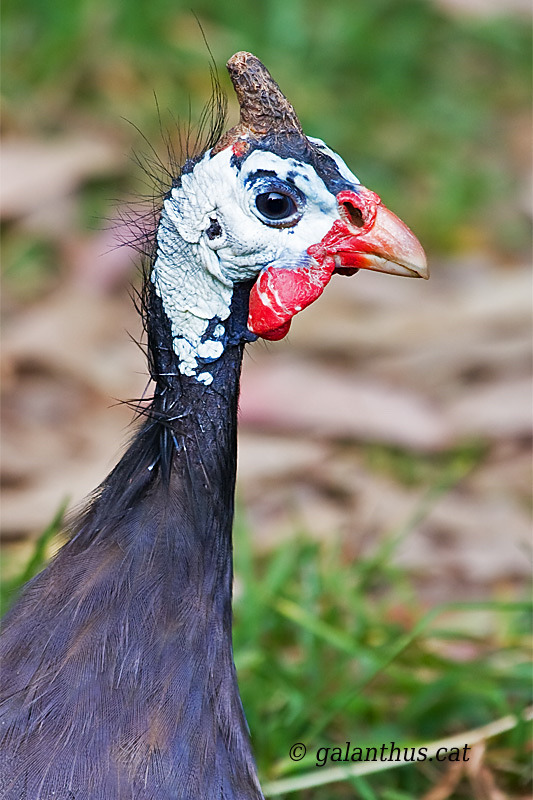


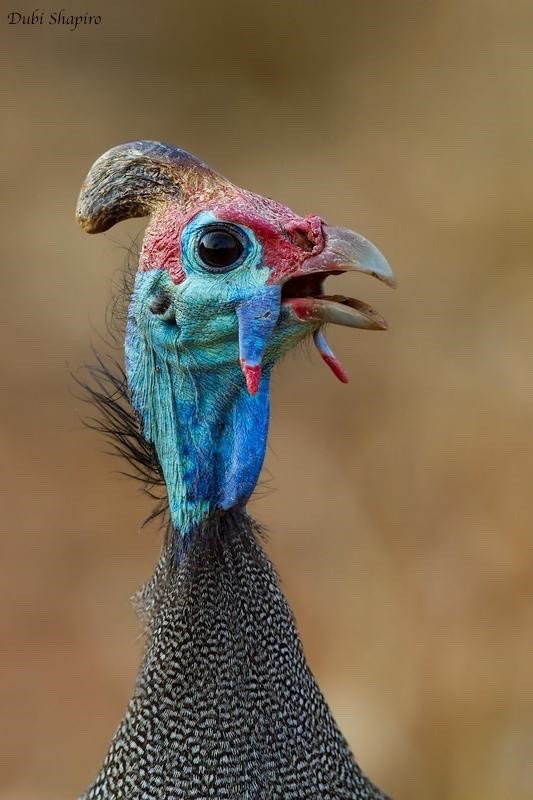
Subspecies of helmeted guineafowl (Numida meleagris)
West African N. m. galeatus [x]
Ethiopian N. m. meleagris [x]
Reichenow’s N. m. reichenowi [x]
Tufted N. m. mitratus [x]
1K notes
·
View notes
Text
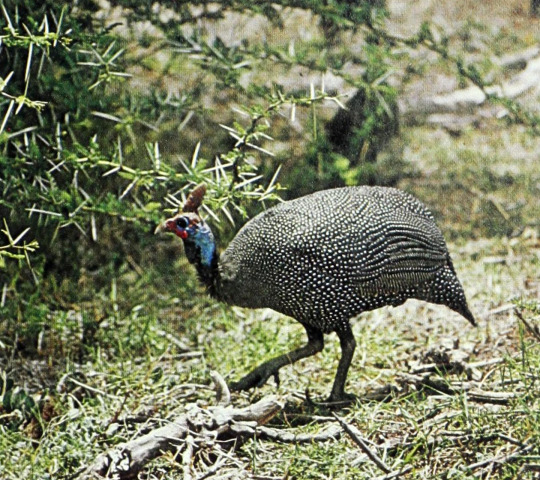
Helmeted guineafowl
By: G. V. Adkin
From: The Complete Encyclopedia of the Animal World
1980
#fave#helmeted guineafowl#guineafowl#galliform#bird#1980#1980s#G. V. Adkin#The Complete Encyclopedia of the Animal World (1980)
146 notes
·
View notes
Photo

Helmeted Guineafowl (Numida meleagris)
Family: Guineafowl Family (Numididae)
IUCN Conservation Status: Least Concern
Widely distributed across Sub-Saharan Africa, Helmeted Guineafowl (singular and plural) are easily recognized thanks to their striking spotted bodies, featherless blue-skinned heads and namesake bony "helmets” (which are short and rounded in females and taller and sharper in males.) Spending the day foraging on the ground and roosting in the branches of trees at night, members of this species favour dry, open habitats and live in large flocks throughout most of the year, breaking up into mating pairs during the spring breeding season (with both parents working in shifts to incubate their eggs, which resemble speckled Chicken eggs and are laid on the ground in ditches lined with twigs and leaves, and to raise their chicks, which are known as keets and are born without the helmets of adults) and returning to larger groups after their chicks have fledged in the late summer. The diet of Helmeted Guineafowl varies seasonally; throughout most of the year they feed largely on grasses, seeds, bulbs and roots, but as their nutritional needs change during the breeding season small animals such as insects, arachnids, snails and small vertebrates become more prominent in their diet - in particular, they are known to feed on large numbers of grass-dwelling ticks during the spring, and in doing so benefit other animals within their range by limiting the ability of ticks to spread between hosts and transfer diseases. While foraging in groups Helmeted Guineafowl vocalize near-constantly to notify their flockmates of their presence, and at the first sign of one of their many predators (including Leopards, Servals and a wide range of large snakes and birds-of-prey) the first individual to spot it will produce an extremely loud alarm call, prompting the group to scatter and run for shelter (although members of this species can fly in short bursts, they are far more capable on the ground and will only take to the air as a last resort.) Both within their home range and throughout the wider world captive populations of Helmeted Guineafowl have been farmed for their meat and eggs for centuries, allowing escaped feral populations to have become established in parts of Australia, Europe and North America.
--------------------------------------------------------------------------
Image Source: https://www.inaturalist.org/taxa/1428-Numida-meleagris
#Helmeted Guineafowl#guineafowl#bird#birds#galliformes#landfowl#zoology#biology#ornithology#animal#animals#wildlife#african wildlife
55 notes
·
View notes
Text

Posting birds until I hit post limit: Helmeted guineafowl
5 notes
·
View notes
Text

cool bird
18 notes
·
View notes
Text
Blue cranes
… and a helmeted guineafowl.

View On WordPress
0 notes
Photo
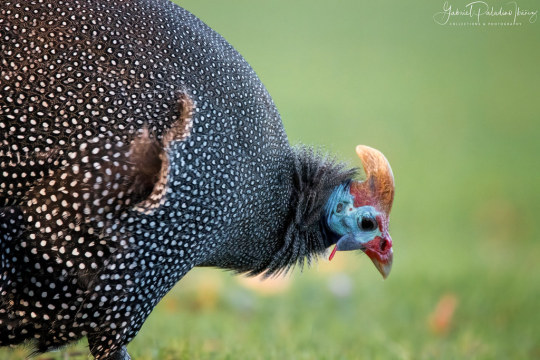
Numida meleagris by Gabriel Paladino Photography https://flic.kr/p/2nAhiWj
1 note
·
View note
Note
Got another bird ask coming your way. Do you think Perlica from Endfield is a Liberi? I see some people draw what I see as feathers in her hair as ears. I personally think she's a pretty safe bet for a Liberi, considering what comes up when you google Perlica (apparently the polish name for guinea fowl).

especially ones with colors like this, for the feathers that is. Numida meleagris, taken from https://hawaiibirdingtrails.hawaii.gov/bird/helmeted-guineafowl-domestic-type/

I haven't really checked that much into Endfield yet because I'm not really interested (and will never be able to play the game with my toaster of a computer)

There's apparently no other meaning to Perlica other than the polish name for the guineafowls, and it wouldn't be surprising for a character to be named after the genus or the name for the animal they're based on (Ptilopsis being the scientist name for northen white faced owl, for example)
But I have to say the plumicorns are weird, it really gives owls vibes (afaik, only Silence, Ptilopsis and Cronin (likely based on an owl) have plumicorns), which, well, only horned owls have plumicorns. And guineafowls do NOT have them. it doesn't ressemble the wing ears like Passenger or Irene have, so it's strange.
But she doesn't show other racial traits, she doesn't seem to have a tail or slit pupils like a Feline, and her plumicorns really do like feathers/fur rather than ears.
As for guineafowl, while I see the name, the ressemblance is... It's far from it. Which I'd find disappointing because I LOVE guineafowls feathers, they're seriously beautiful
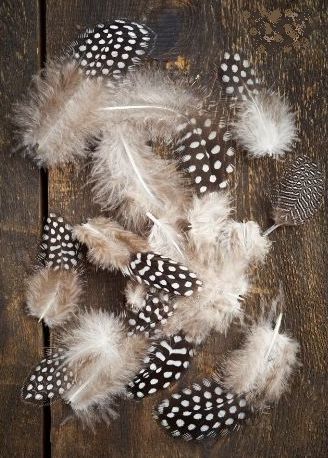
Making a character based on one without those patterns is a waste and I am angry at whoever designed her!! /hj
#arknights#arknights endfield#askiwi#i guess we'll know when the game is out#but honestly my thing is; looks perfectly human? not related to fishes? its a bird
14 notes
·
View notes
Text
#MosaicMonday:
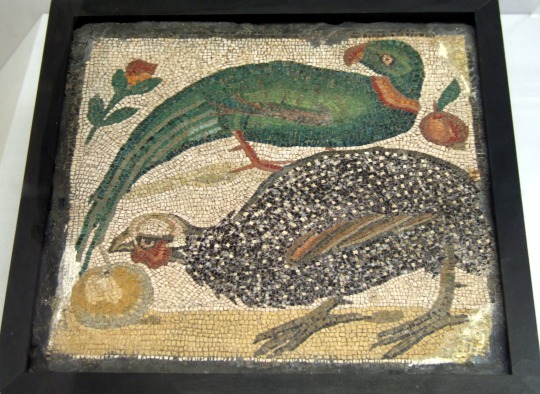
Anicent Roman mosaic, 1st c. CE, Pushkin Museum collection.
🆔 Top = probably an Alexandrine Parakeet (Psittacula eupatria), native to Asia. Bottom = Domesticated Guineafowl, derived from the Helmeted Guineafowl (Numida meleagris), native to Africa. (Both birds known in Europe since Ancient Greek times.)
#animals in art#birds in art#bird#birds#ancient art#Roman art#mosaic#parrot#guineafowl#domesticated guineafowl#Alexandrine Parakeet#Pushkin Museum#Mosaic Monday#species ID
9 notes
·
View notes
Text

Helmeted Guineafowl - Kruger National Park
It is unusual to see these guys perched in trees.
#guineafowl#south africa#africa#original photography on tumblr#kruger national park#southafricanbirds
9 notes
·
View notes
Note
if you were able to keep as many birds as you wanted and like, all their habitats were perfect and maintained and the laws all allowed it and everything, how many birds would you have and what species??
wooooooooooo baby i wish i could upload pictures of all of them but there's a limit of 30 per post and that's nowhere near enough adfasfasdf. soooooo here's the official list of all of my favorite birds!
blue jay, eurasian jay, stellers jay, black collared jay, azure jay, northern cardinal, vermillion cardinal, desert cardinal, pileated woodpecker, great spotted woodpecker, red bellied woodpecker, eastern bluebird, mountain bluebird, gold finch, blue finch, scarlet finch, strawberry finch, rose finches, zebra finch, purple breasted sunbird, violet backed starling, blue vanga, blue dacnis, grandala, indigo bunting, lazuli bunting, rositas bunting, varied bunting, variegated fairy wren, splendid fairy wren, superb fairy wren, white winged fairy wren, philippine fairy bluebird, asian fairy bluebird, taiwan blue magpie, himalayan monal, tui, ravens, crows, blue crowned pigeon, victorian crowned pigeon, american robin, pink robin, lilac-breasted roller, european roller, indian roller, flying roller, blue-bellied roller, malachite kingfisher, woodlands kingfisher, azure kingfisher, rose-crested fruit dove, superb fruit dove, dracula parrot, hyacinth macaw, blue bird of paradise, anna's hummingbird, swordbilled hummingbird, swallowtailed hummingbird, fiery-throated hummingbird, lesser violetear, crowned woodnymph, blue chinned sapphire, mute swan, black swan, black-necked swan, bohemian waxwing, spangled cotinga, banded cotinga, brazilian tanager, australian diamond firetail, flame bowerbird, asian golden weaver, golden pheasant, malayan peacock pheasant, south philippine dwarf kingfisher, guineafowl, green junglefowl, blue-grey tanager, malachite sunbird, great sapphirewing, ruby-topaz hummingbird, fiery topaz, crimson topaz, rainbow bearded thornbill, violet sabrewing, long-tailed sylph, red-tailed comet, variable sunbird, helmeted woodpecker, red-crested cardinal, blue-winged mountain tanager, cinnamon hummingbird, antillean crested hummingbird, violet capped woodnymph, sparkling violetear, blue pitta, mandarin duck
7 notes
·
View notes
Note
Do yu know what other animals were in ancient egypt? I want my oc to have a unique animal and you seem to know a fair amount

I am a well of ridiculous, hyperspecific, only interesting to some trivia lmao.
I would encourage you not to limit yourself to an entirely unique beast- many deities share sacred animals and are still strong individuals. My mind immediately goes to the huge number of feline deities- lions and lionesses in particular- for an example. Additionally, it's nigh impossible for me (with no academic anthropology/egyptology/historic zoology knowledge) to say for certain that particular animals were present in Kemet when they have no documented deities, mummies, or written mentions. I've had to guess for some, deduce by their present day habitats and more or less "timeline" of their species.
It's also important to keep in mind Kemet had contact with other civilizations in other habitats, meaning they were aware of animals not necessarily native to the area. A perfect example is the Hamadryas baboon- they were Nubian animals, but were sacred to both Thoth and Babi, depicted in art, and many mummies of the species have been recovered. A more surprising example is the Syrian brown bear, which was a rare exotic spectacle for the royal elite. There's also the trouble of many species now being extant from the area, meaning they were there but the local population is now extinct- the African sacred ibis is the example my mind comes to first, the waterfowl no longer present along the Nile.
Coincidentally, I've been compiling a list of animals for my own reference to supply a beast or two for the deities that don't have one in tradition.

Birds
Abdim's Stork
African Darter
African Dwarf Kingfisher
African Grass Owl
African Open-billed Stork
African Pied Wagtail
African Sacred Ibis
Asian Green Bee-Eater
Barbary Falcon
Barbary Partridge
Barn Owl
Barn Swallow
Bearded Vulture
Bennu Heron (likely not an actual animal, the Bennu bird inspired by the Goliath Heron- but felt like including it anyhow)
Black Kite
Black Stork
Black-throated Loon
Black-winged Kite
Brown-necked Raven
Carrion Crow
Cattle Egret
Chukar Partridge
Common Buzzard
Common Cormorant
Common Crane
Common Greenshank
Common House Martin
Common Kestrel
Common Kingfisher
Common Pochard
Common Quail
Common Raven
Common Redshank
Common Redstart
Common Sandpiper
Common Spoonbill
Common Teal
Crab Plover
Crested Plover
Dalmatian Pelican
Demoiselle Crane
Eagle (I'm sure there were some, but I can't find any definitive evidence of species in the ancient Kemetic culture- I would take a guess that the Golden Eage was an infrequent visitor)
Egyptian Plover
Egyptian Vulture
European Roller (considered a pest)
European Turtle-dove
Eurasian Coot
Eurasian Crag Martin
Eurasian Teal
Eurasian Wigeon
Fan-tailed Raven
Ferruginous Duck
Gadwall
Garganey
Glossy Ibis
Golden Oriole
Goliath Heron
Great Bittern
Great Bustard
Great Cormorant
Great Egret
Great Spotted Cuckoo
Great White Pelican
Greater Flamingo (possibly not native)
Green Sandpiper
Grey Heron
Griffon Vulture
Helmeted Guineafowl (not native)
Hermit Ibis
Hobby Falcon
Honey Buzzard
Hooded Crow
Hoopoe
Houbara Bustard
House Crow
House Sparrow (pest, hieroglyph had negative connotation)
Kittliz's Plover
Lanner Falcon
Lappet-faced Vulture
Laughing Dove
Lesser Kestrel
Lesser Pied Kingfisher
Little Bittern
Little Bustard
Little Egret
Little Owl
Long-eared Owl
Long-legged Buzzard
Mallard
Marabou Stork
Marsh Sandpiper
Masked Shrike
Merlin
Mourning Wheatear
Northern Lapwing
Northern Pintail
Northern Shoveler
Ostrich
Pale Crag Martin
Peregrine Falcon
Pied Avocet
Pink-backed Pelican
Purple Gallinule
Purple Heron
Red Kite
Red-backed Shrike
Red-footed Falcon
Red-rumped Wheatear
Reed Cormorant
Ring-necked Dove
Rock Dove
Rook
Ruddy Shelduck
Saddle-bill Stork
Saker Falcon
Sandhill Crane
Sand Martin
Sand Partridge
Short-eared Owl
Spotted Redshank
Sooty Falcon
Squacco Heron
Striated Heron
Swan (not native)
Tawny Owl
Tufted Duck
Western Reef Heron
White-backed Night Heron
White-crowned Wheatear
White Stork
White Wagtail
Wood Sandpiper
Yellow-billed Stork
Mammals
Aardvark (possibly not native)
Aardwolf
Addax Antelope
African Clawless Otter
African Giant Shrew
African Green Monkey (not native)
African Grass Rat
African Leopard
African Striped Weasel
Arabian Oryx
Barbary Deer (not native)
Barbary Lion (now extinct)
Barbary Macaque (not native)
Black Rat
Common Patas Monkey (not native)
Black Rhinoceros
Blanford's Fox
Black Wildebeest
Bubal Hartebeest (now extinct)
Cairo Spiny Mouse
Cape Hare
Caracal
Cheetah
Common Beisa Oryx
Common Genet
Desert Hedgehog
Desert Long-eared Bat
Dorcas Gazelle
Desert Black Cobra
Egyptian Fruit Bat
Egyptian Jackal/African Wolf (originally misidentified, now the African Wolf)
Egyptian Mongoose
Egyptian Pipistrelle
Egyptian Red Fox
Egyptian Slit-faced Bat
Egyptian Tomb Bat
Egyptian Weasel
Egyptian Wild Ass
Fennec Fox
Flower's Shrew
Four-toed Jerboa
Geoffroy's Horseshoe Bat
Gerenuk
Giraffe
Golden Spiny Mouse
Greater Egyptian Jerboa
Greater Mouse-tailed Bat
Greater Red Musk Shrew
Hamadryas Baboon (not native)
Hippopotamus
Honey Badger
House Mouse
Lesser Egyptian Jerboa
Lesser Mouse-tailed Bat
Long-eared Hedgehog
Long-nosed Shrew
North African/Bush Elephant (vilified and driven out by prehistoric Egyptians)
North African Crested Porcupine (not native)
Nubian Ibex (not native)
Olive Baboon (likely not native, sometimes called the Anubis Baboon)
Persian Fallow Deer (not native)
Rhim Gazelle
Rüppell's Fox
Sand Rat
Serval (likely not native, but Ra was depicted as one)
Scimitar Oryx
Soemmerring's Gazelle
Somali Dwarf Shrew
Spotted Hyena
Spotted-necked Otter
Striped Hyena
Syrian Brown Bear (not native)
Wild Boar
White Rhinoceros
Yellow Baboon (not native, species' epithet means 'dog-head' in Greek)
Vervet Monkey
Reptiles
African Chameleon
African Rock Python
Arabian Horned Viper
Desert Horned Viper
Desert Monitor Lizard
Egyptian Cobra
Egyptian Gecko
Egyptian Sand Boa
Egyptian Sand Racer
Egyptian Tortoise
Javelin Sand Boa
Insects/Arachnids/Etc.
Nile Crocodile
Nile Soft-shelled Turtle
Red Spitting Cobra
Saharan Sand Viper
Amphibians
African Common Toad
European Green Toad
Marsh Frog
Mascarene Grass Frog
Nile Delta Toad
Nile Valley Toad
Camel Spider
Banded Garden Spider
Brown Widow Spider
Carpenter Ant
Centipede
Click Beetle
Common Housefly (NOT considered a pest, actually revered as a protector)
Danaid Eggfly
Desert Ant
Desert Locust
Devil's Coach Horse Beetle
Dorippus Tiger Butterfly
Dragonfly
Flea
Fire Ant
Jewel Beetle
Gaudy Commodore Butterfly
Half-edged Wall Jumping Spider
Large Salmon Arab Butterfly
Maggot/Carrion Fly
Migratory Locust
Messor Ant
Millipede
Red-breasted Goose
Mosquito (pest)
Moths in the Saturniidae family
Palestine Yellow Scorpion
Pantropical Jumping Spider
Pharaoh Ant
Plain Tiger Butterfly
Praying Mantis
Scarab Beetle
Sinai Baton Blue Butterfly
Southern White Admiral Butterfly
Scorpions in the Buthidae and Scorpionidae families
Water Scorpion
Fish, Mollusks, etc. (Keep in mind fish were taboo in Kemet)
Abju
African Catfish
African Tigerfish
Bayad Fish
Blacktip Shark
Blue-spotted Stingray
Bolti
Chromis
Cichlid
Cornish Jack
Eel
Flatfish
Gilt-head Bream
Great Barracuda
Leopard Shark
Lepidotus Fish
Loligo Squid
Lungfish
Moon Fish
Mullet
Nile Barb
Nile Bichir
Nile Carp
Nile Mormyrid
Nile Labeo
Nile Perch
Nile Puffer
Parrotfish
Reef Manta Ray
Reef Shark
Sandbar Shark
Sea Snake
Scorpionfish
Spiny Lobster
Sturgeon
Surgeonfish
Swordfish
Thornback Ray
Thresher Shark
Tiger Shark
Tilapia
Triggerfish
Unicorn Fish
Wrasse
Zebra Shark
Domestic Animals
Bean Goose
Brant Goose
Camel (not introduced until Middle/New Kingdom)
Cats (Mau breed)
Chickens (not introduced until New Kingdom era)
Cow/Bull
Dogs (Saluki, Greyhound, Basenji, and Pharaoh Hound breeds)
Donkey
Egyptian Goose
Greater White-fronted Goose
Greylag Goose
Honey Bees
Horse (not introduced until New Kingdom)
Pig
Ram
My sources, if you're interested, are the Wikipedia page for Egyptian wildlife, a few different diving sites about the Mediterranean and Red Sea, a couple books I own on Ancient Egypt that describe the geography of the periods, and this lovely reddit multi-post
Sheep
13 notes
·
View notes
Text

Helmeted guineafowl
By: Unknown photographer
From: Dandy Gum Cards
1969
36 notes
·
View notes